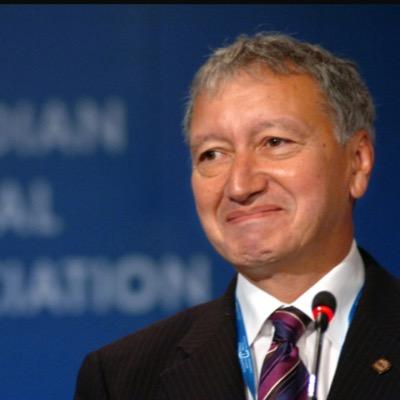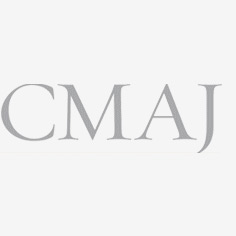
Dr. Brian Day
@DrBrianDay 
- Past President Canadian Medical Association
- Past President Arthroscopy Association of North America
- Honourary Associate Professor University of British Columbia
- 2014 Doctors of BC Don Rix Leadership Award


 His own private hospital
His own private hospital
Deborah Jones
CMAJ 1997;157:297-300
In brief
Dr. Brian Day had a simple solution when it became increasingly difficult to book operating room time in Vancouver. He built his own hospital. The Cambie Surgical Centre, which treats patients from BC and around the world, has 2 main operating rooms, 10 recovery beds and 5 private rooms for extended stays. "What I've done," says Day, "is say that if there are no operating rooms at UBC, I'll build my own."
En bref
Le Dr Brian Day a trouvé une solution simple lorsqu'il est devenu de plus en plus difficile de réserver du temps à la salle d'opération à Vancouver. Il a construit son propre hôpital. Le Centre chirurgical Cambie, où l'on traite des patients de la Colombie-Britannique et du monde entier, compte 2 salles d'opération principales, 10 lits de réveil et 5 chambres privées de séjour prolongé. «Ce que j'ai fait, affirme le Dr Day, c'est dire que s'il n'y a pas de salle d'opération à UBC, je vais construire la mienne.»
The sky is darkening and evening rush hour fading on Vancouver's West Side. Orthopedic surgeon Brian Day steers his Jeep off the University of British Columbia campus and soon arrives in the city's bustling hospital district.
At the spanking new Cambie Surgery Centre, a private hospital unique in Canada, he parks in the loading bay and heads to the third floor, where he helps himself to a cart loaded with $15 000 in the latest high-tech equipment used for arthroscopic surgery. With practised efficiency and barely a nod from nursing staff tending an overnight patient from Japan, Day wheels the cart into an elevator and makes off with the gear.
Back at UBC, he unloads it at the hospital and heads to an operating room where a patient is already prepped. With state-of the-art equipment now at hand, he performs arthroscopic surgery on the patient's shoulder, then sends the man packing to resume normal activities in 6 weeks.
Had he used the hospital's existing equipment he'd have saved himself the bother of playing courier, but it is older and requires a 15-cm incision. That would not only put the patient out of commission for 4 months, but would also have offended Day's sensibilities: he wants to work at the highest possible level in his field.
A bizarre convergence
In a different world, all public hospitals would purchase all available state-of-the art equipment for each surgical specialty. Alternatively, surgeons like Day would book wealthy patients into well-equipped private hospitals. Instead, in BC's version of Canada's Byzantine medicare system, Day spends hours shuttling privately owned equipment about for publicly funded surgery. It's a bizarre example of the convergence of infinite technological development and the finite pool of public health care dollars. In particular, that convergence puts the squeeze on specialists like Day, who perform mostly elective procedures in an atmosphere of constraint in which critical procedures soak up the available funding.
But Day's way of addressing this convergence is unique. With some 20 partners, he has built his own private hospital. The promotional Web site (www.csc-surgery.com) for the centre puts it this way: "Cambie Surgery Centre can proudly boast that it is Canada's most modern surgical unit. It is the first facility of its kind to be built in Canada, and it is located in the beautiful West Coast city of Vancouver, British Columbia."
Why did he do it? Maybe he got tired of performing surgery at 2 am, the period when he could obtain access to an operating room at the UBC campus hospital. Maybe it was watching his colleagues move to the US to work with the latest equipment in accessible operating rooms. Maybe it was having his OR hours trimmed to 6.5 per week, down from 15, and seeing his patients wait-listed for longer and longer periods. Maybe it was his political conviction that some private health care should coexist with Canada's publicly funded system. Whatever the cause, he decided that he could no longer live entirely within the existing system, and with a group of like-minded physicians the 1970 graduate of the University of Manchester began bucking it with epiphanic zeal.
The result is the $4-million Cambie Surgery Centre, which Day, the president, has referred to as a pilot project. A tidy, square 3-storey building on a corner lot, Cambie sprang up unobtrusively in a neighbourhood of hospitals, laboratories, apartment buildings and malls. It is bordered by a busy thoroughfare and shopping area on one side and homes in the process of gentrification on the other.
On the outside Cambie is neat and simple, unostentatious, very Canadian. Inside the scene changes, with esthetic touches such as elegant wood furnishings and fine area rugs differentiating it from the area's more Spartan public facilities.
As its Web site states, the centre's goal is to develop and maintain a centre of excellence in surgery. It can provide plastic and cosmetic surgery, as well as dental, oral, orthopedic (including arthroscopic and sports injuries), general, laparoscopic, gynecologic, ophthalmologic, urologic and otolaryngologic procedures. "Most of the medical staff hold faculty positions at the University of British Columbia," the Web site says, "and many are national and international leaders in their specialty."
$450 an hour for an OR
The original concept was simple. Cambie would charge customers facility fees ($450 per hour for rental of an operating room, including staff and dressings). Doctors who provided services would collect their fees from medicare, in the case of BC residents, or directly from the patient, in the case of visitors.
The target market was to be a range of short-stay surgical procedures: cosmetic surgery, sports injuries, cholecystectomies and oral surgery. "Essentially," says Day, "the kinds of procedures that get put at the bottom of the waiting list in terms of priority of patients requiring treatment."
Execution of the concept, however, was anything but simple. It took years of political manoeuvring, raising financing through 22 owner-investors (including 15 physicians) and navigating red tape, permits and approvals.
More significantly, plans progressed amid the ongoing furore over privatization of medicine in Canada. For much of the past 2 years, Day was in the thick of that ongoing debate. As president of an association representing about 30 private clinics in BC, he appeared on local and national media to debate privatization with government officials and others. "If there were no waiting lists in the public sector, there would be no need for a private facility," he stated. "But what has happened is Canadian politicians have promised the public a complete smorgasbord of health care and no limits on expenditures. In the 1990s that is a promise they cannot fulfil. We have to step in or see patients wait in line."
Nationally and in BC, at least so far, Day's side has failed to sway public officials and others intent on protecting medicare. UBC health care economist Robert Evans voiced a common concern -- that private clinics will erode funding and support for the public system. "A lot depends on whether these clinics are really private, or are they parasitical in the private system?" he says. "There is little private care in the world -- typically you find a blend of the two. It's that mix of private and public that's been a thorn in the heel of every system in the world."
Indeed, as ground was broken and construction proceeded on the Cambie Centre, the federal government cracked down on private facility fees and the provincial government passed legislation that forced doctors to opt out of medicare entirely if they charged BC residents facility fees for provincially insured services. Day considers the legislation overkill. "Bill 54 infringes on citizens' rights," he says angrily. "The government is controlling citizens."
The legislation seems to be effective at holding privatization plans at bay, at least for now. However, Evans questions whether future governments will agree with the pro-privatization argument that public money can be saved by letting wealthy patients pay for insured services rather than standing in the queue.
While the plans for Cambie proceeded and the debate continued, provincial officials pointedly and publicly stated that investors in private clinics were risking their money. "It is a high risk," acknowledges Day. "Every investor who put up money knew this was a high-risk venture, but based on experience elsewhere in North America -- not in Canada where there are no similar facilities -- multipurpose surgical centres have all remained viable."
Still, when the governments took action they could have effectively stripped the Cambie Centre of all its patients and surgeons before it even opened its doors. Instead, the clinic's investors put their back-up plan into effect: it would restrict itself to noninsured services for BC patients seeking dental or cosmetic surgery, and market its entire range of services and expertise abroad.
Critics weigh in.
Critics of privatization don't object if the clinic is truly private and export oriented, but they question whether Canada's system for educating health care providers and the provision of emergency and other services in public hospitals -- which private centres require -- serve as subsidies for for-profit exports of health care.
"If it's totally private," says Dr. Sam Sheps, head of the Department of Health Care and Epidemiology at UBC, "I wonder why care is so much cheaper here. Is it because resources supported by tax dollars are being used?"
The Cambie Centre, which has 2 main operating rooms, a dentallaser suite and 10 recovery beds, is currently operating 5 days a week at about 50% capacity. Its 5 extended short-stay private rooms "offer a level of comfort and privacy that is not readily available in public institutions. Telephone, radio, television and video players are available in each room."
Its roster of "on staff " surgeons includes more than 30 plastic surgeons, about 30 orthopods and eye and dental surgeons. They are backed up by 3 administrators and the full-time equivalent of 12 nurses.
During a recent week the centre was home to several British Columbians undergoing cosmetic surgery, as well as patients from other provinces, the US, Japan, United Kingdom, Russia, Cyprus and Argentina. The out-
of-province visitors were receiving procedures that are publicly insured in BC; this means BC residents couldn't receive them -- they must either travel out of province themselves, or queue for treatment at a public hospital.
Thus far most international and local customers have been referred to the centre by word-of-mouth within the medical community, but Day says the centre is planning to advertise internationally. The incentives for foreigners are competitive prices -- malpractice insurance and some supplies are cheaper in Canada than the US, and doctors' fees are lower. Canada's good reputation for high health care standards also enters the equation.
"Canadians have never gone after the offshore market of health care," says Day. "It's a whole new market we're trying to attract by selling Canadian expertise at a low cost. Doctors' fees here are very low. For example, for one operation I get paid $300, while in Seattle the surgeon's fee is $1500 [see CMAJ 1997;156:960]."
Since the BC government passed its legislation and the Cambie Centre opened, Day has deliberately scaled back his campaign promoting private clinics, hoping that if he leaves the government alone it will leave his centre alone. (Indeed, many local doctors are not even aware that the centre opened. He rarely returns phone calls from reporters and refuses most speaking engagements. Since the centre opened in mid-1996, it has received nowhere near the publicity received by other private facilities, such as eye-surgery clinics in Alberta, and has virtually escaped public controversy surrounding the privatization issue.)
This state of affairs will not last. One local newspaper published a straightforward business story about the centre under the taunting headline, "Out-of-province patients keep clinic busy while BC residents wait for operations." And Day acknowledges that simply by providing prompt care to paying foreigners while some BC residents face lineups, the Cambie Centre is occupying a frontline position in the philosophical battle over private clinics. Critics point out that separation of private and public medicine is almost always impossible; for one thing, medical staff receive subsidized public training. Day responds that by catering to foreign customers, private clinics benefit the Canadian economy and, in the long run, provide taxes and medical expertise to meet the health care needs of Canadians.
"This is potentially the biggest industry in Canada," says Day, "yet our political leaders are afraid to go after this market because it will expose the deficiencies in our own system, namely surgical waiting lists.
"How can it be that foreigners come into Canada, have medical treatment by the best doctors in our city right away, and as a BC patient I would have to wait 6 months?"
Frustration with waiting lines, however, is only one of his complaints about medicare-funded medicine. "The equipment is terrible," he says. During a recent operation he performed at the UBC hospital, he says, an anesthetized patient was kept waiting on the table for 45 minutes, with the OR team in attendance, while a taxi brought a piece of equipment from another hospital.
Constraints on budgets have meant a reduced inventory of even some basic equipment in public hospitals, at least in elective areas. And only plush private clinics can afford to dip into the gushing river of high-tech, state-of-the-art gadgets flowing from around the world.
The centre makes this point clear at its Web site. "Cambie Surgery Centre will continue to keep pace with evolving technology and to acquire desirable modern equipment and instrumentation. The Coherent Ultrapulse 5000C laser, arthroscopic shoulder and hip instrumentation, Telepresence 3-D video-imaging system and multipurpose operating microscope represent just some of the high-tech devices the centre offers. In this facility, surgeons are able to access modern technology that has not been readily available in our hospitals."
Day says the main reason for establishing Cambie is to provide both the latest equipment and abundant operating room time. An added bonus is that he gets to attend equipment fairs and buy what he wants without going through the committee process found in public hospitals. He then borrows the same equipment to use on public patients at the UBC hospital.
Day is hardly alone in his frustration with limitations on resources. His solution, however, is unusual.
"What I've done is say that if there are no operating rooms at UBC, I'll build my own."